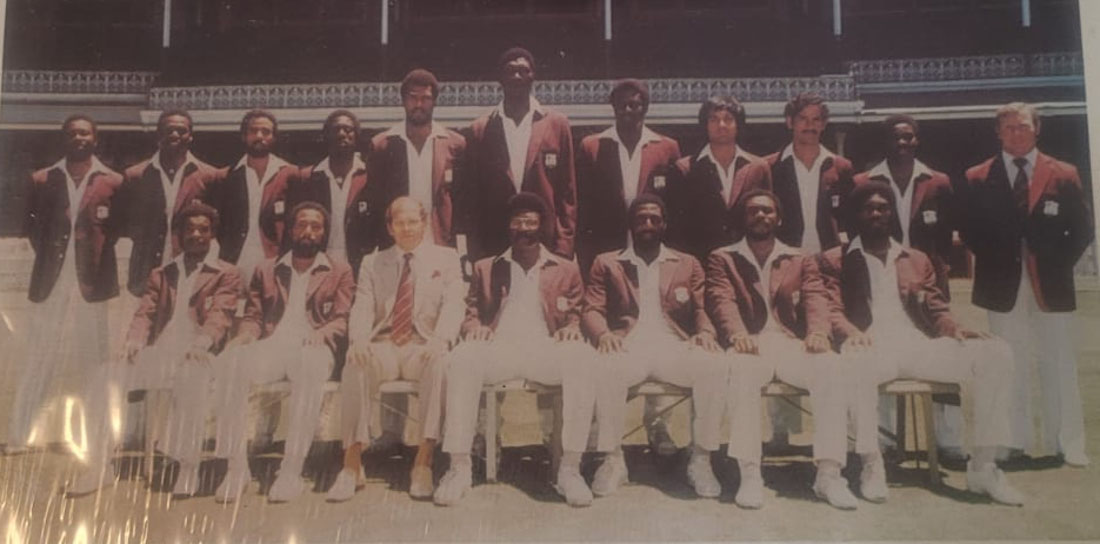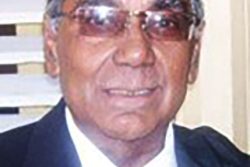The loss
On the 1979 – 80 Tour of Australia, the West Indies won the three-match Test series 2-0, their first ever series victory in six attempts Down Under, and regained the Sir Frank Worrell Trophy for the first time since their initial lien, following the 2–1 win in the 1965 Test series in the Caribbean. Two years later, the team returned for another shared Test tour, and the Benson & Hedges World Series Cup, a Triangular One Day International Tournament with Pakistan and Australia.
After waiting 15 years to get their hands on the Sir Frank Worrell Trophy it seemed to be slipping right out of the West Indies’ grasp as soon as they had gotten hold of it. In the First Test at Melbourne, 26th – 30th December, 1981, the traditional annual Australian Boxing Day Test match, the West Indies lost a low scoring game. (In Search of West Indies Cricket, A Boxing Day century for the ages, SN, 2nd September, 2018). Scores: Australia: 198; K Hughes 100*, M Holding 5 for 45, & 222; A Border, 66, B Laird, 64, M Holding, 6 for 62. West Indies: 201; L Gomes, 55, D Lillee 7 for 83, & 161. Australia won by 56 runs.
The defeat terminated a 15-Test unbeaten streak for the West Indies dating back to February 1980, the drawn Second Test, in Christchurch, New Zealand. In the span of 22 months, in four series on as many continents, they had won four Tests and drawn 11.
Opening bookend
The start and culmination of streaks of this nature can never be predicted, as they tend to evolve into a life of their own making, with a string of close calls, twists and unexpected turns, and narrow escapes. The statistician’s record of the commencement of the streak is the drawn Second Test at Sydney, a West Indian graveyard, if ever there was one. Despite having the upper hand for most of the match, the West Indies’ quest to level the series was defied by John Dyson. Drafted into the side to bat first wicket down, to take the pressure off the embattled Australian Captain Greg Chappell, Dyson opened in the second innings. He held the West Indies pace attack at bay for six and a quarter hours, remaining undefeated on 127, as the match was abandoned due to bad light, with Australia, chasing 373, on 200 for four. It was the first occasion that a Test match between Australia and the West Indies at Sydney finished a draw. On six previous tours (there was no Test at Sydney in 1979/80), the visitors had lost six times and won twice. It was an omen of things to come.
Hair raising chases and few narrow escapes
In the Third Test at Adelaide, the West Indies pulled a rabbit out of a hat. At the start of the fifth (final) day, 3rd February, the Australians were on cruise control, as the momentum pendulum, which had swung back and forth throughout the match, now appeared firmly in their corner. At the start of play, Australia were 341 for four, 190 runs ahead, with the game headed for an inevitable draw. The overnight batsmen, Kim Hughes, 72*, and Rod Marsh, 22*, survived for 25 minutes before Marsh drove straight to Desmond Haynes at short extra cover. Twenty minutes later, Faoud Bacchus, fielding three metres from the bat, at forward short leg, displayed lightning reflexes as he plucked a powerful cover drive off of Hughes’ bat to end his innings. In the short span of 50 minutes, the hosts lost six wickets for 24 runs, as Joel Garner grabbed four wickets for five runs off 20 deliveries.
Chasing 236 in two sessions and 15 minutes, the West Indies diligently applied themselves to the task. By the tea interval, the target was 115, with one hour and 20 overs remaining and seven wickets in hand, due in the main to a 100 partnership between Gordon Greenidge, 52, and Viv Richards, 50. An undefeated innings of 77 from Captain Clive Lloyd saw the visitors home, by five wickets with 17 balls to spare. The Sir Frank Worrell Trophy was duly retained.
The West Indies didn’t play another Test match until a year later, 23rd – 28th February, 1983, at Sabina Park, Kingston, Jamaica. It was the first of 11 Tests between them and India for the calendar year – five in the Caribbean, and six in India – and it produced another nail biter. The well-versed West Indians, requiring 172 runs in half an hour plus 20 overs, surpassed the target with six wickets down and four balls to spare. (In Search of West Indies Cricket, Magic at Sabina Park, SN, 2nd April, 2023). The West Indies won the five-match series 2-0, and apart from Mohinder Amarnauth, (598 runs at an average of 66.44), the Indian batting lineup never threatened to dominate the West Indian fast bowlers. Alas, the unseasonal wet weather was also a major factor in the final results.
The West Indies then visited India for a six-Test series, following their shock defeat in the Prudential World Cup Final, a watershed moment in the history of Indian cricket. The West Indies avenged the World Cup defeat with an emphatic 3-0 thumping of India. Their fast bowlers, led by Malcolm Marshall and Michael Holding, and ably supported by Winston Davis, Wayne Daniel and Andy Roberts, were constant thorns in the sides of the Indian batsmen. Only Sunil Gavaskar (505 runs at 50.50) and Dilip Vengsarkar (425 runs at 53.12) were able to withstand their barrage on a consistent basis. In six innings, Mohinder Amarnauth, the plunderer in the Caribbean, was reduced to five ducks and a single run.
The West Indies emphasised their superiority from the First Test, winning by an innings with a day to spare. Even in the Third Test, a low-scoring affair on India’s newest Test ground with “one of the poorest pitches on which I have played Test cricket” according to Lloyd, and questionable umpiring decisions, the West Indies maintained the upper hand to win by 138 runs. The series clincher, an innings victory with a day to spare in the Fifth Test at Calcutta, demonstrated the strength of the West Indian professional approach to Test cricket. Replying to India’s first innings total of 241, the West Indies were faltering at 88 for five, with the first five in the lineup back in the pavilion. The Skipper, with the assistance of the bowlers, Marshall, 54, and Holding, 17, led the team’s clawing back into the match, to reach 213 for 8. Lloyd and Roberts, 68, then swung the game, and the series, away from the hosts with a new West Indian ninth-wicket record partnership in Tests of 161, compiled over three hours and 40 minutes, almost two sessions. Lloyd was 161 not out at the end, having scored his 18th Test century, and seventh against India, with his stay in the middle having occupied eight and a quarter hours. Arriving at the wicket with his team floundering at 42 for four, Lloyd demonstrated the mental tenacity required to perform at the highest level of the game and the ability to impose one’s will on a game of Test cricket. By the close of the third day’s play, India, faced with a first innings deficit of 136, were in dire straits at 36 for five. Following the rest day, India were dismissed for 90 in 30 overs, their lowest total against the West Indies, as Marshall and Holding wreaked havoc with the Indian batting lineup. The West Indies arrived in India intending to avenge their World Cup defeat, which they clearly did, but in doing so, they issued a statement to the rest of the cricketing world, ‘Be prepared. This is serious business.’
In 1984, the West Indies played 14 Test matches, and started another which spilled over into 1985. The first five were in the Caribbean against the Australians, who put up a brave fight, but in the end, were no match to the steamrolling hosts who never lost a single second innings wicket throughout the series. The first two Tests were drawn affairs, which with a little bit of luck, or better timing, could easily have gone in favour of the hosts. In the First Test at Bourda, the West Indies, chasing 323, were 250 without loss, when the game was called off, with Greenidge, 120* and Desmond Haynes, 103*. In the Second Test, at the Queen’s Park Oval, Australia, 213 behind on first innings, were on the rocks at 196 for eight, about an hour before tea on the final afternoon with only middle order batsman Allan Border, and the two fast bowlers, Rodney Hogg and Terry Alderman standing between them and a West Indian victory. Inspired by Border, the Australian fast bowlers dug in, and when Viv Richards, leading the side in the absence of an injured Lloyd, conceded the match, Australia were safe at 299 for nine. Alderman, 21*, had withstood the hosts’ attack for an hour and three-quarters, while Border, followed up his first innings 98* with an even century, 100*.
The West Indian juggernaut then swung into top gear for the rest of the series, with ten-wicket victories at the Kensington Oval, Barbados (Third Test), and Sabina Park (Fifth Test), and an innings victory at the Antigua Recreation Ground (ARG), in the Fourth Test. Apart from Border (521 runs at 74.42), who scored more than twice the runs at almost three times the average of his teammates, the Australians were outplayed by the “strongest, most professional and most disciplined” team, their Captain Kim Hughes acknowledged at the end of the tour.
On 13th May, less than two weeks after the Fifth Test, the twelfth West Indian team to tour England arrived at Heathrow Airport in London, to a barrage of negative press castigating them for their slow over rates, due to the heavy reliance on fast bowling, and their intimidating use of bouncers. The West Indies response was to complete a historic 5-0 sweep of their hosts, now famously referred to as the ‘Blackwash.’ After posting 606 in their only innings in the First Test at Edgbaston, they swept aside the Englishmen by an innings and 180 runs in four days. In the Second Test at Lord’s, they completed an improbable run chase against the clock on the final day, scoring 344 for one, to win with 11.5 overs remaining, as Greenidge, 214*, and Larry Gomes, 92*, shared a new West Indian record unbroken second wicket partnership of 287 (In Search of West Indies Cricket, “Assignment at Lord’s”, SN, 13th August, 2023). An eight-wicket victory at Headingley, was followed by an innings victory at Old Trafford, where the visitors recovered from 70 for four to post 500, thanks to Greenidge’s second double century of the tour, 223, Jeffrey Dujon’s 101, and nightwatchman Davis’ knock of 77. In August, at the Kennington Oval in Surrey, the West Indies’ unofficial ‘home-away-from-home’, they completed the sweep by with a 172-run victory, equalling the eight straight wins of Warwick Armstrong’s 1920/21 Australian Test teams, one of the most hallowed records in Test cricket.
Next stop, Down Under. The eighth official West Indian tour party to Australia arrived in Sydney, on Monday, 15th October, 1984. Although it was the team’s fourth visit in six seasons, it was the first full tour since the 5-1 humiliation in 1975/76.
After a wobbly start to the First Test in Perth, the West Indians recovered from 104 for five, to score 416, thanks to centuries from Gomes, 127, and Dujon, 139. The fast bowling quartet of Marshall, Holding, Garner and Courtney Walsh then dismissed the hosts for 76 – their lowest total in Tests versus the West Indies – and 228, to secure an innings victory, and a new record for consecutive Test victories. In setting the new standard, the West Indies displayed a level of perfection in team play and professionalism rarely seen in sport, and it was a reflection of the high demands Lloyd placed on himself and his team members. An eight-wicket triumph at Brisbane and at Adelaide, in the Second and Third Tests, respectively, stretched the consecutive winning streak to 11 matches, and guaranteed the retention of the Sir Frank Worrell Trophy.
The Fourth (Boxing Day) Test in Melbourne saw the desperate Australian selectors make four changes to their side, bringing in Andrew Hilditch, Greg Matthews, and debutantes Murray Bennett and Craig McDermott to face an unchanged West Indies team. A conservative approach by Lloyd, saw his declaration coming 15 minutes into the final morning, setting Australia a target of 370 in 275 minutes plus 20 overs. It was a little too late as Hilditch, upon his return to Test cricket after five years, held out for 338 minutes, with gritty support from Border, wicketkeeper Steve Rixon, and finally Bennett, earned the home side a hard-earned draw. Seventeen balls were left when Hilditch was the seventh batsman dismissed, but the West Indies couldn’t remove the tailenders. The winning streak had been broken, but a new record of 27 consecutive Test matches without defeat had been established, surpassing the mark of 26 set by England between June 1968 and August 1971.
Sydney bookend
The Fifth Test began three days later at Sydney. Lloyd’s final Test as captain was not a memorable one, as the West Indies succumbed to the leg spin of Bob Holland and the orthodox left arm spin of Bennett by an innings and 55 runs. Scores: Australia: 471; Kepler Wessels, 173, Border, 69. West Indies: 163; Holland 6 for 84, Bennett 2 for 45, & 253, Lloyd, 72, Richards, 58, Holland, 4 for 90, Bennett, 3 for 79. The unbeaten streak which had begun three years earlier on the 2nd January in the Second Test at Sydney had ended on the 2nd January, 1985, in the Fifth Test at Sydney.
The West Indies’ Test cricket record of 27 consecutive matches without a loss lies in the shadow of the colossal 15-year (1980-1995) streak of 29 successive Test series without defeat. The achievement spans six series on four continents spread over three calendar years, from January 1982 to December 1984. The record is now approaching its fortieth year of existence, and its magnitude continues to gain more prominence with each passing year.
Other unbeaten streaks
Australia: 25 – March 1946 to February, 1951
Australia: 22 – September, 2005 to January, 2008
India:19 – August, 2015 to February, 2017
England:18 – February, 1959 to June, 1961
Australia: 18 – September, 1999 to February, 2001
Australia:17 – October, 1956 to December, 1959
India: 17 – September, 1985 to March, 1987
Australia: 16 – December, 1920 to January, 1925
Pakistan: 16 – November, 1986 to April, 1988
Consecutive Test wins
Australia have two 16-win streaks: October 1999 to February 2001, and December 2005 to January 2008. The West Indies’ win streak of 11 is the third longest.
Note
Dating back to the First Test versus New Zealand in February, 1980, at Dunedin, New Zealand, the West Indies played 43 Test matches up to (and including) the Fourth Test at Melbourne, incurring only one loss, the First Test at Melbourne, December, 1981, versus Australia.










